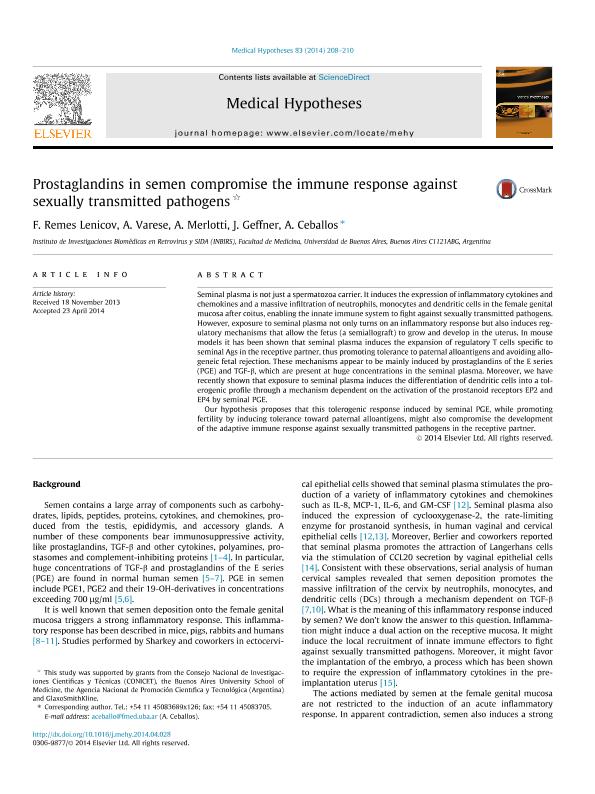Artículo
Prostaglandins in semen compromise the immune response against sexually transmitted pathogens
Remes Lenicov, Federico ; Varese, Augusto
; Varese, Augusto ; Merlotti Ippólito, Antonela
; Merlotti Ippólito, Antonela ; Geffner, Jorge Raúl
; Geffner, Jorge Raúl ; Ceballos, Ana
; Ceballos, Ana
 ; Varese, Augusto
; Varese, Augusto ; Merlotti Ippólito, Antonela
; Merlotti Ippólito, Antonela ; Geffner, Jorge Raúl
; Geffner, Jorge Raúl ; Ceballos, Ana
; Ceballos, Ana
Fecha de publicación:
05/2014
Editorial:
Elsevier
Revista:
Medical Hypotheses
ISSN:
0306-9877
Idioma:
Inglés
Tipo de recurso:
Artículo publicado
Clasificación temática:
Resumen
Seminal plasma is not just a spermatozoa carrier. It induces the expression of inflammatory cytokines and chemokines and a massive infiltration of neutrophils, monocytes and dendritic cells in the female genital mucosa after coitus, enabling the innate immune system to fight against sexually transmitted pathogens. However, exposure to seminal plasma not only turns on an inflammatory response but also induces regulatory mechanisms that allow the fetus (a semiallograft) to grow and develop in the uterus. In mouse models it has been shown that seminal plasma induces the expansion of regulatory T cells specific to seminal Ags in the receptive partner, thus promoting tolerance to paternal alloantigens and avoiding allogeneic fetal rejection. These mechanisms appear to be mainly induced by prostaglandins of the E series (PGE) and TGF-β, which are present at huge concentrations in the seminal plasma. Moreover, we have recently shown that exposure to seminal plasma induces the differentiation of dendritic cells into a tolerogenic profile through a mechanism dependent on the activation of the prostanoid receptors EP2 and EP4 by seminal PGE.
Palabras clave:
Prostaglandinas
,
Semen
,
Infección Viral
,
Inmunidad Antiviral
Archivos asociados
Licencia
Identificadores
Colecciones
Articulos(INBIRS)
Articulos de INSTITUTO DE INVESTIGACIONES BIOMEDICAS EN RETROVIRUS Y SIDA
Articulos de INSTITUTO DE INVESTIGACIONES BIOMEDICAS EN RETROVIRUS Y SIDA
Citación
Ceballos, Ana; Geffner, Jorge Raúl; Merlotti Ippólito, Antonela; Varese, Augusto; Remes Lenicov, Federico; Prostaglandins in semen compromise the immune response against sexually transmitted pathogens; Elsevier; Medical Hypotheses; 83; 2; 5-2014; 208-210
Compartir
Altmétricas



